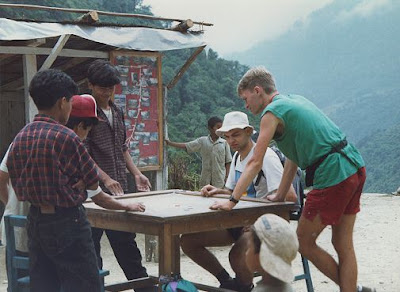Nepal Partourism: 13 Ways to Make It Happen
My first three pieces for Wandering Educators concerned varieties of what I call "participatory tourism" -- or "partourism." To reprise what I have already ventured about this paradigm: I am not suggesting that we need to invent a new way of traveling, or impose new guidelines, or categorize travelers as partourists/non-partourists, or anything like that. On the contrary: partourism as a concept should remain vague, precisely because we don't need someone laying out rules as to how we should spend our money or interact with natives or minimize our ecological footprint. I just mean that it would be good if, in some of our traveling, we managed to interact with our hosts in ways that involve us as more than voyeurs, ways that provide the basis for long-term relationships and return visits; and also that it would behoove tourism entrepreneurs and policy makers to facilitate experiences that engage visitors, entice them to stay longer, and promote return visits.
There are, of course, countless varieties of partourism opportunities. Unfortunately, there is distinct much-of-a-muchness about the examples I have given so far: trekker adopts orphan, climber adopts village, student returns with clinic, and more recently, a naive sideline commentator gets roped into setting up hospitals, running schools, and saving the world. These stories involve serious partour commitments; but you can find less extravagant partour-ops, or even partour moments. With this essay, therefore, I will at drawing up a representative list -- a baker's dozen of ideas, including some half-baked. For now, I'll add only a few explanatory words; in the months to come, I'll develop each into an article, with more detailed recommendations and caveats.
1) Learn to play the local games. Of course, basketball, soccer, and volleyball are great for cross-cultural experiences, but as conversation starters the more sedentary board games are hard to beat. Checkers and chess are common in Nepal; however, if you really want to make an impression, learn bagh chal (tigers and goats) and carrom.

Bagh Chal, a.k.a. Tigers and Goats. Photo courtesy of James Masters. Rules are available at his Web site (http://www.mastersgames.com/rules/tigers-goats-rules.htm), as well as game sets (http://www.mastersgames.com/cat/board/tigers-goats.htm).
2) Study. There are plenty of resources for studying Nepali before your travel. Depending on where you want to spend time, you will probably find the local languages are better door-openers: even if you speak very little, your interest in Newari, Tamang, Tibetan, Sherpa, or any other minority idiom will elicit a warm response. Other areas of study will result in more limited but perhaps deeper encounters with your guru and with fellow students: there are abundandant opportunities to study Buddhism, meditation, yoga, dance, music, cooking. Kathmandu Valley is rich in crafts: jewelry making, fabric weaving, basket making, wood carving, papier mache masks, thanka painting, paper making and on and on. If you don't find a class, you can organize one or hire a tutor.
3) Start a non-profit. If you want to set up a non-governmental organization (NGO) in Nepal, you'll need Nepali collaborators, but the process is simple, and legal help is cheap.
4) Start a business. I'll share some lessons I learned in setting up Sunrise Pashmina.
5) Write. If you start a blog before traveling, you can be sure you'll meet people who share your interests once you get to Nepal. If you're not expecting to get paid more than a few dollars, you can write an article (or even a recurring column) for one of the many English-language publications.
6) Organize an event. Setting up a conference is much cheaper than you'd think. What about a sporting event, a thematic tour, an exhibit of your photographs, a slide lecture, a concert? In Nepal, everything is possible, whether or not you have the experience or credentials. Just do it.
7) Publish a book. Or a periodical. High quality, low costs -- except when it comes to international shipping.
8) Volunteer. Work in an orphanage. Take part in a medical expedition. Build a bridge. Give a day... or a lot longer.
9) Get a job. Teaching gigs are particularly easy to come by. If you're teaching locals (English as a Second Language, for example), the pay won't be much to write home about. You may even want to tutor pro-bono: show villagers how to set up a Peltric hydro-electric set or do a new knitting stitch, for example. On the other hand, if you can teach something that tourists and expatriates are interested in (ballroom or other forms of dance), you may be able to finance your stay.
10) Sponsor an orphan. We like Rainbow Children Home.
11) Rent an apartment or house. There are places available for short term, at all levels of comfort. Even with a cook, gardener, and nanny, the costs are extremely low. Whether you rent a spartan flat or a grandiose villa, you will automatically become part of a community, with landlord, neighbors, and daily chores that will transport you from the tourist cocoon into the real world that you came so far to experience.
12) Commission artwork or other collectibles (paintings, carved frames, jewelry, costumes, carpets...). While you're at it, consider a hand-tailored suit or cocktail dress. Bring photos from your favorite fashion magazines for your tailor to copy, or just let him design something for you.
13) Marry a Nepali. You can take a chance on meetings someone once you get there. Or you can improve your odds by making an Internet connection (or several) before coming.
There are plenty of other possibilities. If you've got ideas, I'd like to hear them.

Carrom. Photo courtesy of James Masters, shown here losing to local talent. Rules available at http://www.mastersgames.com/rules/carrom-rules.htm; games for sale at http://www.mastersgames.com/cat/table/carrom-u.htm.
Seth Sicroff, Nepal Editor for Wandering Educators
Manager, Sunrise Pashmina
Feature photo: Danish tourist introduces Sherpanis to the Scandinavian version of the purl stitch. Photo courtesy and copyright Seth Sicroff
-

- Log in to post comments




















